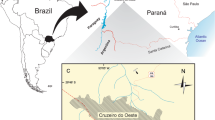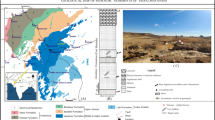Abstract
Theropod dinosaurs were the dominant predators in most Mesozoic era terrestrial ecosystems1. Early theropod evolution is currently interpreted as the diversification of various carnivorous and cursorial taxa, whereas the acquisition of herbivorism, together with the secondary loss of cursorial adaptations, occurred much later among advanced coelurosaurian theropods1,2. A new, bizarre herbivorous basal tetanuran from the Upper Jurassic of Chile challenges this conception. The new dinosaur was discovered at Aysén, a fossil locality in the Upper Jurassic Toqui Formation of southern Chile (General Carrera Lake)3,4. The site yielded abundant and exquisitely preserved three-dimensional skeletons of small archosaurs. Several articulated individuals of Chilesaurus at different ontogenetic stages have been collected, as well as less abundant basal crocodyliforms, and fragmentary remains of sauropod dinosaurs (diplodocids and titanosaurians).
This is a preview of subscription content, access via your institution
Access options
Subscribe to this journal
Receive 51 print issues and online access
$199.00 per year
only $3.90 per issue
Buy this article
- Purchase on Springer Link
- Instant access to full article PDF
Prices may be subject to local taxes which are calculated during checkout



Similar content being viewed by others
Change history
17 June 2015
Minor changes were made to author affiliations.
References
Rauhut, O. W. M. The interrelationships and evolution of basal theropod dinosaurs. Spec. Pap. Palaeont. 69, 1–213 (2003)
Paul, G. S. The segnosaurian dinosaurs: relics of the prosauropod–ornithischian transition? J. Vert. Paleont. 4 507–515 (1984)
Salgado, L., De La Cruz, R., Suárez, M., Gasparini, Z. & Fernández, M. First Late Jurassic dinosaur bones from Chile. J. Vert. Paleont. 28 529–534 (2008)
De la Cruz, R. & Suárez, M. Geología del área de Puerto Guadal-Puerto Sánchez, región de Aisén del General Carlos Ibáñez del Campo, escala 1:100.000 [in Spanish]. Carta Geológica de Chile 95, 1–117 (2006)
Madsen, J. H. Allosaurus fragilis: a revised osteology. Utah Geol. Min. Surv. Bull. 109, 1–163 (1976)
Martinez, R. N. et al. A basal dinosaur from the dawn of the Dinosaur Era in Southwestern Pangaea. Science 331 206–210 (2011)
Lautenschlager, S. Morphological and functional diversity in therizinosaur claws and the implications for theropod claw evolution. Proc. R. Soc. Lond. B 281 1471–1473 (2014)
Bonaparte, J. F. The Gondwanan theropod families Abelisauridae and Noasauridae. Hist. Biol. 5 1–25 (1991)
Otero, A. & Pol, D. Postcranial anatomy and phylogenetic relationships of Mussaurus patagonicus (Dinosauria, Sauropodomorpha). J. Vert. Paleont. 33 1138–1168 (2013)
Novas, F. E. Alvarezsauridae, Cretaceous basal birds from Patagonia and Mongolia. Mem. Queensl. Mus. 39, 675–702 (1996)
Weishampel, D. BDodson, P., Osmólska, H., & Hilton, R. P. The Dinosauria 2nd edn (Univ. of California Press, 2004)
Yates, A. M. A new species of the primitive dinosaur Thecodontosaurus (Saurischia: Sauropodomorpha) and its implications for the systematics of early dinosaurs. J. Syst. Palaeontology 1 1–42 (2003)
Hutchinson, J. R. The evolution of pelvic osteology and soft tissueson the line to extant birds (Neornithes). Zool. J. Linn. Soc. London 131 123–168 (2001)
Sadleir, R., Barrett, P. M. & Powell, H. P. The anatomy and systematics of Eustreptospondylus oxoniensis, a theropod dinosaur from the Middle Jurassic of Oxfordshire, England. Mon. Palaeont. Soc. London 160, 1–82 (2008)
Novas, F. E. Dinosaur monophyly. J. Vertebr. Paleontol. 16 723–741 (1996)
Novas, F. E. The tibia and tarsus in Herrerasauridae (Dinosauria, incertae sedis) and the origin and evolution of the dinosaurian tarsus. J. Paleontol. 63, 677–690 (1989)
Zanno, L. E. Osteology of Falcarius utahensis: characterizing the anatomy of basal therizinosaurs. Zool. J. Linn. Soc. 158 196–230 (2010)
Galton, P. M. The ornithischian dinosaur Hypsilophodon from the Wealden of the Isle of Wight. Bull. Brit. Mus. Geol. London 25, 1–152 (1974)
Smith, N. D. et al. Megaraptor (Dinosauria: Tetanurae) in Australia; evidence for faunal interchange between eastern and western Gondwana during the Early Cretaceous. Proc. R. Soc. Lond. B 275 2085–2093 (2008)
Nesbitt, S. J. et al. A complete skeleton of a Late Triassic saurischian and the early evolution of dinosaurs. Science 326 1530–1533 (2009)
Carrano, M. T., Benson, R. B. J. & Sampson, S. D. The phylogeny of Tetanurae (Dinosauria: Theropoda). J. Syst. Paleont. 10 211–300 (2012)
Zanno, L. E., Gillette, D. D., Albright, L. B. & Titus, A. L. A new North American therizinosaurid and the role of herbivory in “predatory” dinosaur evolution. Proc. R. Soc. Lond. B 276 3505–3511 (2009)
Zanno, L. E. & Makovicky, P. J. Herbivorous ecomorphology and specialization patterns in theropod dinosaur evolution. Proc. Natl Acad. Sci. USA 108 232–237 (2011)
Norman, D. B. & Weishampel, D. B. in Biomechanics and Evolution (eds Rayner, J. M. V. & Wootton, R. J.) 161–181 (Cambridge Univ. Press, 1991)
Barrett, D. P. The diet of ostrich dinosaurs (Theropoda: Ornithomimosauria). Palaeontology 48 347–358 (2005)
Xu, X. et al. A Jurassic ceratosaur from China helps clarify avian digital homologies. Nature 459 940–944 (2009)
Barrett, P. M. Paleobiology of herbivorous dinosaurs. Annu. Rev. Earth Planet. Sci. 42 207–230 (2014)
Ezcurra, M. D. & Agnolín, F. L. A new global palaeobiogeographical model for the late Mesozoic and early Tertiary. Syst. Biol. 61 553–566 (2012)
Acknowledgements
We thank P. Barrett, A. Milner and R. Butler for comments on early versions of this manuscript. We are grateful to C. Alsina, M. Milani, R. Stoll and M. Aranciaga for field assistance and technical preparation of Chilesaurus specimens. G. Lio executed the silhouette of Chilesaurus in Fig. 1. C. Burke offered support to conduct fieldwork and technical preparation of the specimens. We are indebted to the Agencia Nacional de Promoción Científica y Tecnológica (PICT 2010-066 to F.E.N.) and the Fondo Nacional de Desarrollo Científico y Tecnológico (no. 1121140 and 1030162 to M.S.) for continuing financial assistance.
Author information
Authors and Affiliations
Contributions
F.E.N., L.S., M.S., F.L.A., M.D.E., N.R.C., A.O.V. and D.R.-R. designed the study, collected data, performed the comparative and analytical work, and wrote the paper. R.d.l.C. and M.P.I. collected data and contributed to the writing and discussion.
Corresponding author
Ethics declarations
Competing interests
The authors declare no competing financial interests.
Additional information
Data have been deposited in ZooBank under Life Science Identifier (LSID) http://zoobank.org/urn:lsid:zoobank.org:act:7B6DE8C7-C78D-48C0-B818-65C454AEFB58.
Extended data figures and tables
Extended Data Figure 1 Holotype of Chilesaurus diegosuarezi gen. et sp. nov. (SNGM-1935) as it was found in the field.
Cd, caudal vertebrae; Cv, cervical vertebrae; Dv, dorsal vertebrae; Lf, left forelimb; Lfem, left femur; Lsc, left scapulocoracoid; Ltib, left tibia; Rf, right forelimb; Sk, skull.
Extended Data Figure 2 Selected skull bones of Chilesaurus diegosuarezi gen. et sp. nov. (SNGM-1935; holotype).
a, Right frontal in dorsal view; b, right postorbital in lateral view; c, incomplete right (?) maxilla in lateral view; d, right dentary in medial view. al, alveolus; ao, antorbital opening; or, orbital rim; t, teeth; tf, lower temporal fossa rim.
Extended Data Figure 3 Scapular girdle and selected forelimb bones of Chilesaurus diegosuarezi gen. et sp. nov. a,
b, Left scapula and coracoid (SNGM-1938) in lateral (a) and posterior (b) views. c, Left humerus (SNGM-1938) in anterior view; d, left radius (SNGM-1935, holotype) in lateral view; and e, left ulna (SNGM-1935, holotype) in lateral view. cf, coracoid foramen; dp, deltopectoral crest; gl, glenoid cavity; ol, olecranon process.
Extended Data Figure 4 Selected hindlimb elements of Chilesaurus diegosuarezi gen. et sp. nov. a,
b, Right femur (SNGM-1935) in anterior (a) and lateral (b) views. c–e, Articulated right tibia and fibula (SNGM-1935) in posterior (c), medial (d) and proximal (e) views. at, anterior trochanter; cn, cnemial crest; f, fibula; fh, femoral head, 4t, fourth trochanter; gt, greater trochanter, ic, inner condyle; oc, outer condyle; t, tibia; tfc, tibiofibular crest.
Extended Data Figure 5 Bivariate plots showing the results of the morphospace occupation analysis of Chilesaurus diegosuarezi gen. et sp. nov. based on characters of different regions of the skeleton, taken from the modified data matrix and the first and second axes of the principal coordinate analysis.
a–d, Bivariate plots using all the characters (a), cranial characters (b), hindlimb zeugopodium and stylopodium characters (c), and tarsal and pedal characters (d). The convex hulls represent different dinosauriform groups rather than statistically distinct clusters. Light grey polygon, non-neotheropod dinosauriforms; blue polygon, non-averostran neotheropods; green polygon, ceratosaurs; pink polygon, megalosauroids; dark grey polygon, allosauroids; light blue polygon, coelurosaurs; red dot, Chilesaurus.
Supplementary information
Supplementary Information
This file contains Supplementary Text and Data, Supplementary Figures and additional references, which are divided into the following sections: Occurrence, age, and preservation of the holotype and referred specimens of Chilesaurus diegosuarezi gen. et sp. nov.; Phylogenetic analyses; and Morphospace analysis. (PDF 3286 kb)
Rights and permissions
About this article
Cite this article
Novas, F., Salgado, L., Suárez, M. et al. An enigmatic plant-eating theropod from the Late Jurassic period of Chile. Nature 522, 331–334 (2015). https://doi.org/10.1038/nature14307
Received:
Accepted:
Published:
Issue Date:
DOI: https://doi.org/10.1038/nature14307
Comments
By submitting a comment you agree to abide by our Terms and Community Guidelines. If you find something abusive or that does not comply with our terms or guidelines please flag it as inappropriate.



